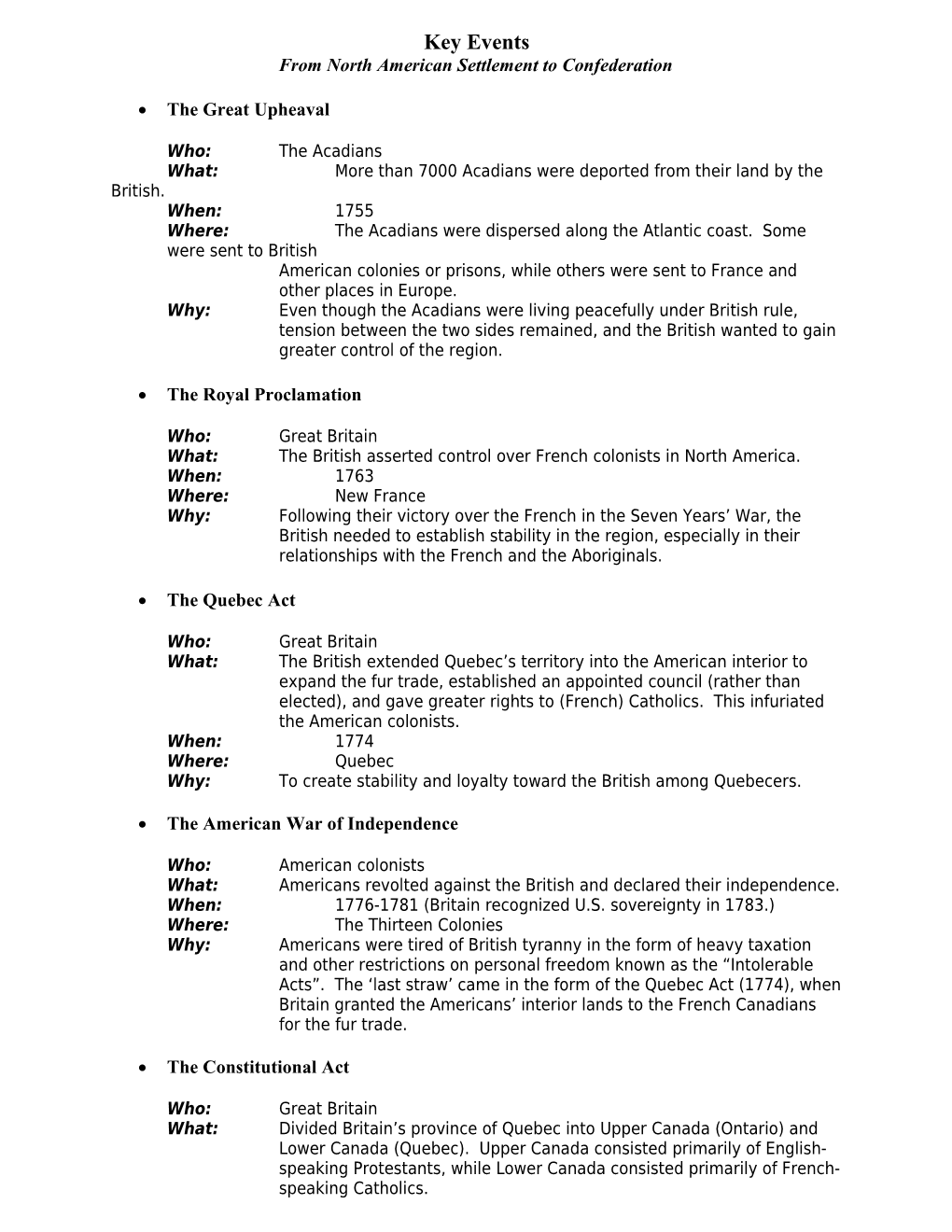Key Events
From North American Settlement to Confederation
· The Great Upheaval
Who: The Acadians
What: More than 7000 Acadians were deported from their land by the British.
When: 1755
Where: The Acadians were dispersed along the Atlantic coast. Some were sent to British
American colonies or prisons, while others were sent to France and other places in Europe.
Why: Even though the Acadians were living peacefully under British rule, tension between the two sides remained, and the British wanted to gain greater control of the region.
· The Royal Proclamation
Who: Great Britain
What: The British asserted control over French colonists in North America.
When: 1763
Where: New France
Why: Following their victory over the French in the Seven Years’ War, the British needed to establish stability in the region, especially in their relationships with the French and the Aboriginals.
· The Quebec Act
Who: Great Britain
What: The British extended Quebec’s territory into the American interior to expand the fur trade, established an appointed council (rather than elected), and gave greater rights to (French) Catholics. This infuriated the American colonists.
When: 1774
Where: Quebec
Why: To create stability and loyalty toward the British among Quebecers.
· The American War of Independence
Who: American colonists
What: Americans revolted against the British and declared their independence.
When: 1776-1781 (Britain recognized U.S. sovereignty in 1783.)
Where: The Thirteen Colonies
Why: Americans were tired of British tyranny in the form of heavy taxation and other restrictions on personal freedom known as the “Intolerable Acts”. The ‘last straw’ came in the form of the Quebec Act (1774), when Britain granted the Americans’ interior lands to the French Canadians for the fur trade.
· The Constitutional Act
Who: Great Britain
What: Divided Britain’s province of Quebec into Upper Canada (Ontario) and Lower Canada (Quebec). Upper Canada consisted primarily of English-speaking Protestants, while Lower Canada consisted primarily of French-speaking Catholics.
When: 1791
Where: Quebec
Why: Following the American Revolution, many of the United Empire Loyalists came to Quebec. They pressured Britain into giving them elected assemblies, freehold land tenure and the establishment of the Anglican Church.
· The War of 1812
Who: United States vs British North America
What: The US fought against British forces and Canadian militia. There were military advances crossing both British and US boundaries, but ultimately there were no territorial changes.
When: 1812
Where: Atlantic Ocean; Canadian frontier; also the southern States
Why: Americans were frustrated by British trade restrictions, as well as British support for Natives in the American interior.
· The Upper and Lower Canada Rebellions
Who: Canadian reformers vs British forces
What: Canadians under British rule wanted to change the political system. In Lower Canada, Louis-Joseph Papineau led reformers against the Chateau Clique. In Upper Canada, William Lyon Mackenzie led reformers against the Family Compact. Both rebellions were quickly stamped out by British forces.
When: 1837
Where: Lower Canada (Quebec); Upper Canada (Ontario)
Why: Reformers sought change from the system established in 1791, where elected assemblies were controlled by British administrators and appointed councils.
· The Act of Union
Who: Great Britain
What: Upper and Lower Canada were united under a single parliament, getting rid of the previously-separate governments. The result was the creation of Canada West and Canada East. English was declared the only official language in Canada. Also, both CW and CE were given equal representation, despite CE’s far greater population.
When: 1841
Where: Canada
Why: After the rebellions in 1837, Britain’s Lord Durham made several recommendations for reform in Canada. His promotion of responsible government was rejected, but his suggestion of assimilating French culture into English culture was accepted.
· The Charlottetown Conference
Who: Maritime colonies; Canadian politicians, including the Great Coalition
What: The political leaders of the British North American colonies gathered to discuss the possibility of uniting to form a new dominion.
When: 1864
Where: Charlottetown
Why: The Great Coalition were looking to create a federal union of all BNA colonies. When they heard that the Maritime colonies were convening to discuss their own union, the Canadian politicians came to Charlottetown to convince them of the benefits of Confederation.
· The British North America (BNA) Act
Who: Great Britain
What: After discussing the details of the Charlottetown Conference and the Quebec Resolutions with the Canadian politicians from 1866 to 1867, the British agreed to pass into law the union of the British North American colonies (Ont, Que, NB and NS).
When: 1867 (The BNA Act was passed in March 1867.
The Dominion of Canada became official on July 1, 1867.
Where: Canada
Why: Britain’s colonies no longer needed its military or financial support, and now sought their own independence. Britain, meanwhile, was still prosperous in its own right, and no longer wanted to maintain its BNA colonies financially.
